How to Assemble: Craftsman Electric Start Capable Backpack User Manual

Content
Introduction
Introducing the Craftsman Electric Start Capable Backpack - the perfect tool for all your outdoor power equipment needs. This innovative backpack features an electric start capability, making it easy to start and operate your equipment without the need for manual pulling. The estimated price for this product is $299, and it is set to launch in Spring 2023.
Parts List
REPLACEMENT PARTS: MODEL 316. 794011 ELECTRIC START CAPABLE 4-CYCLE BACKPACK BLOWER
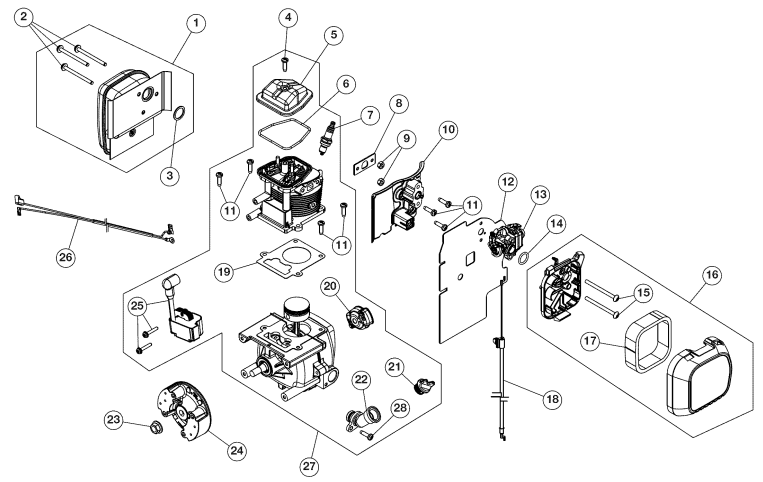
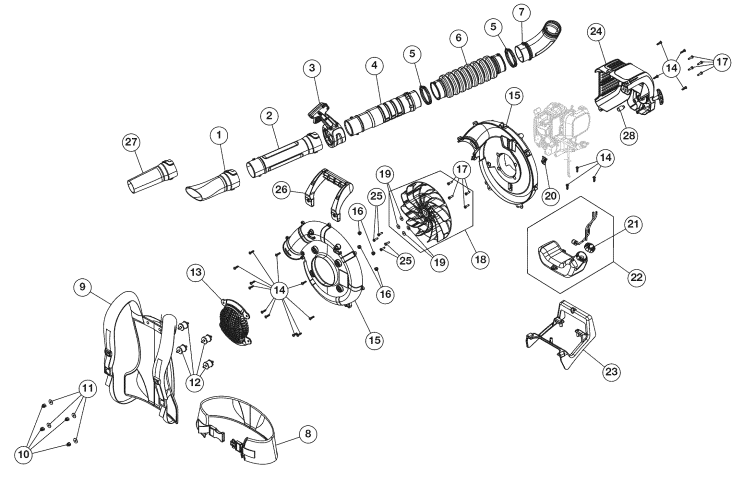
Detailed Specifications
The Craftsman Electric Start Capable Backpack is designed with the following key features:
- Engine Type: Air-Cooled, 4-Cycle
- Displacement: 32 cc (1.95 cu. in.)
- Blower Air Volume: up to 500 cfm
- Blower Air Speed: up to 150 mph
- Valve Clearance: 0.003 - 0.006 in. (0.076 - 0.152 mm)
- Spark Plug Gap: 0.025 in. (0.635 mm)
- Spark Plug: Champion® RDZ4H or equivalent plug
- Lubrication: SAE 30 Oil
- Crankcase Oil Capacity: 3.04 oz. (90 ml)
- Fuel Tank Capacity: 26 oz. (769 ml)
- Approximate Unit Weight (No fuel): 15 lbs. (6.8 kg)
Know Your Unit
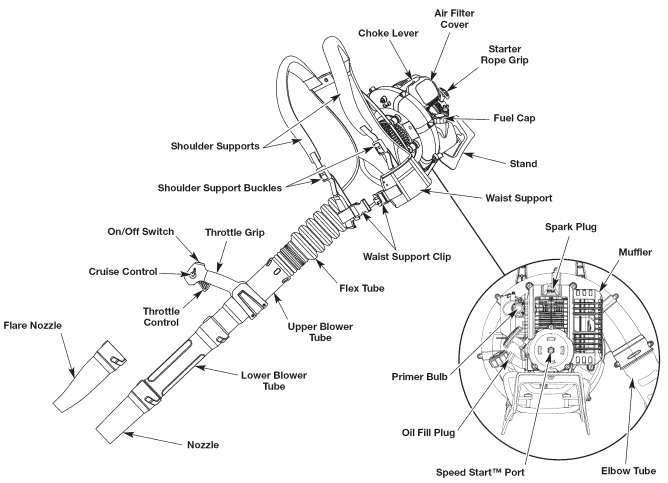
APPLICATIONS
Cleaning yards, garages, driveways, porches, patios, around walls, fences and more
ASSEMBLY TOOLS REQUIRED
- Flat-head Screwdriver
- T-20 Torx® Screwdriver
All specifications are based on the latest product information available at the time of printing. We reserve the right to make changes at any time without notice.
Assembly
ASSEMBLING THE BLOWER TUBE
WARNING: To avoid serious personal injury and damage to the unit, shut the unit off before removing or installing blower tubes or nozzles.
Installing the Flex Tube
- Place a hose clamp around one end of the flex tube.
- Slide the flex tube and hose clamp onto the elbow tube.
- Tighten the screw on the hose clamp with a flat-head screwdriver.
Installing the Upper Blower Tube
- Place a hose clamp around the other end of the flex tube.
- Slide the flex tube and hose clamp onto the upper end of the upper blower tube.
Tighten the screw on the hose clamp with a flat-head screwdriver.
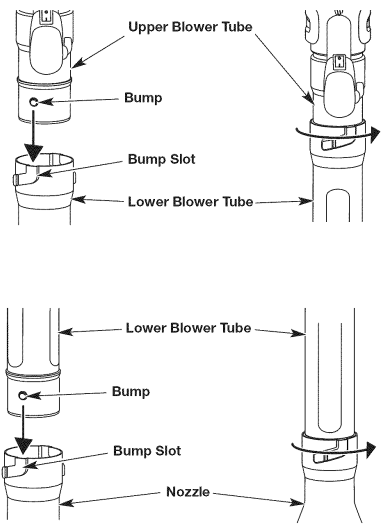
Installing the lower Blower Tube
- Align the bump on the upper blower tube with the bump slot on the lower blower tube.
- Insert the upper blower tube into the lower blower tube.
- While holding the upper blower tube, twist the lower blower tube clockwise until it locks into place.
Installing the Nozzle
- Align the bump on the lower blower tube with the bump slot on the nozzle.
- Insert the lower blower tube into the nozzle.
While holding the lower blower tube, twist the nozzle clockwise until it locks into place.
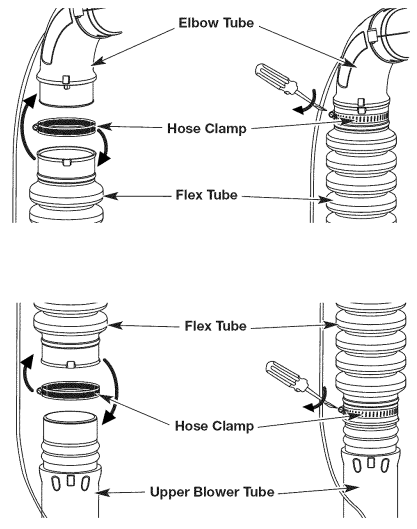
Securing the Throttle Cables
- Wrap a zip tie around the elbow tube and the throttle cables.
- Carefully tighten the zip tie. Do not crimp the throttle cables.
Adjusting the Throttle Grip
- Move the throttle grip to a location on the upper blower tube that provides the best grip.
Tighten the two screws on the throttle grip with a T-20 Torx screwdriver until the throttle grip is secure.
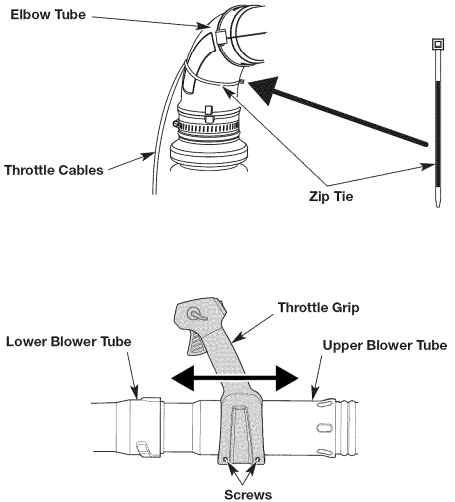
Oil & Fuel
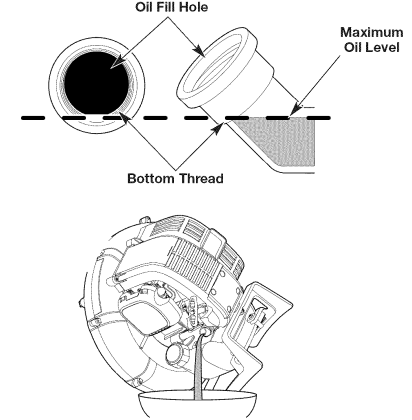
USING THE RIGHT OIL
Use a high-quality SAE 30 weight oil of API (American Petroleum Institute) service class SJ. DO NOT use dirty oil. Failure to use clean oil of the correct type can cause premature engine wear and failure.
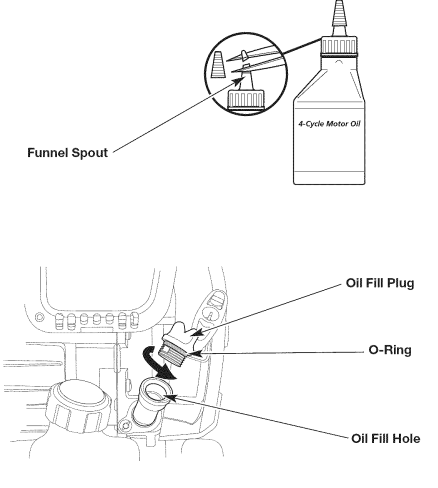
ADDING OIL: INITIAL USE
WARNING: OVERFILLING THE CRANKCASE MAY CAUSE SERIOUS PERSONAL INJURY. Check the oil level before each use. The importance of maintaining the proper oil level cannot be overemphasized. Change the oil according to the Maintenance Schedule.
NOTE: This unit was shipped without oil in the crankcase. Oil must be added before starting the unit.
NOTE: This unit comes with a 3.04 fluid oz. (90 ml) bottle of oil.
- Unscrew the top of the oil bottle. Remove the paper seal. Reinstall the top of the oil bottle.
- Remove the cap from the oil bottle. Cut the tip off the funnel spout.
- Set the unit on a flat, level surface.
- Unscrew the oil fill plug.
- Tilt the unit 30° to the side.
- Pour the entire bottle into the oil fill hole (Fig. 8). DO NOT overfill. Refer to Checking the Oil Level.
NOTE: Never add oil directly to the fuel tank. This unit has a four- cycle engine. DO NOT mix oil with gasoline. - Wipe up any oil that may have spilled.
- Reinstall the oil fill plug.
NOTE: Make sure the 0-ring is in place on the oil fill plug.
NOTE: Save the empty oil bottle. Use the bottle to measure the correct amount of oil during future oil changes.
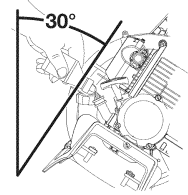
USING THE RIGHT FUEL
The use of old fuel is the most common cause of performance problems. Use only fresh, clean unleaded gasoline, or use Tru Fuel 4-Cycle Fuel (PN 4727238).
Definition of Blended Fuels
Today's fuels are often a blend of gasoline and oxygenates such as ethanol, methanol or MTBE (ether). Alcohol-blended fuel absorbs water. As little as 1 % water in the fuel can make fuel and oil separate, forming acids when stored. ALWAYS use fresh fuel (less than 30 days old).
NOTE: Dispose of old fuel according to federal, state and local regulations.
Using Blended Fuels
If using a blended fuel:
- Always use fresh unleaded gasoline
- Use the fuel additive STA-BIL or an equivalent
- Drain the tank and run the engine dry before storing the unit
WARNING: DO NOT USE E85 FUEL IN THIS UNIT. It ethanol will likely damage this engine and void the warranty.
Using Fuel Additives
Use a fuel additive, such as STA-BIL Fuel Stabilizer or an equivalent, to inhibit corrosion and minimize gum deposits. Add 0.8 oz. (23 ml) of fuel additive per gallon of fuel, according to the instructions on the container. NEVER add fuel additives directly to the unit's fuel tank.
FUELING THE UNIT
WARNING: Gasoline is extremely flammable. Ignited vapors may explode. Always stop the engine and allow it to cool before filling the fuel tank. Do not smoke while filling the tank. Keep sparks and open flames at a distance from the area.
WARNING: Remove the fuel cap slowly to avoid injury from fuel spray. Never operate the unit without the fuel cap securely in place.
WARNING: Add fuel in a clean, well ventilated outdoor area. Wipe up any spilled fuel immediately. Avoid creating a source of ignition for spilled fuel. Do not start the engine until fuel vapors dissipate.
- Position the unit with the fuel cap facing up.
- Remove the fuel cap.
- Place the fuel container spout into the fill hole on the fuel tank and fill the tank.
NOTE: Do not overfill the tank. - Wipe up any fuel that may have spilled.
- Reinstall the fuel cap.
- Move the unit at least 30 ft. (9.1 m) from the fuel container and the fueling site before starting the engine.
STARTING AND STOPPING
WARNING: Operate this unit only in a well-ventilated outdoor area. Carbon monoxide exhaust fumes can be lethal in a confined area.
WARNING: Avoid accidentally starting the unit. To avoid serious injury, the operator and the unit must be in a stable position when pulling the starter rope (Fig. 12).
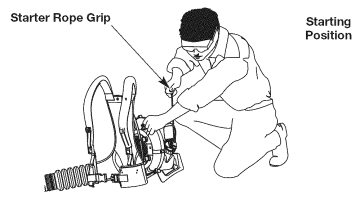
STARTING INSTRUCTIONS
- Check the oil level. Refer to Checking the Oil Level.
- Fill the fuel tank. Refer to Fueling the Unit.
NOTE: There is no need to turn the unit on. The On/Off switch is in the ON ( I ) position at all times. - Slowly press and release the primer bulb 10 times.. If fuel cannot be seen in the primer bulb, press and release the primer bulb until fuel is visible.
- Move the choke lever to Position 1..
NOTE: DO NOT squeeze the throttle control until step 9. - Crouch in the starting position.
- DO NOT squeeze the throttle control. Pull the starter rope with a controlled and steady motion 5 times.
NOTE: This unit uses the INCREDI-PUll starting system, which significantly reduces the effort required to start the engine. - DO NOT squeeze the throttle control. Move the choke lever to Position 2.
- DO NOT squeeze the throttle control. Pull the starter rope with a controlled and steady motion 3 to 5 times to start the engine.
- Squeeze and hold the throttle control. Allow the engine to warm up for 30 to 60 seconds.
Continue to squeeze the throttle control. Move the choke lever to Position 3 . and continue warming the engine for an additional 60 seconds. The unit may be used during this time.
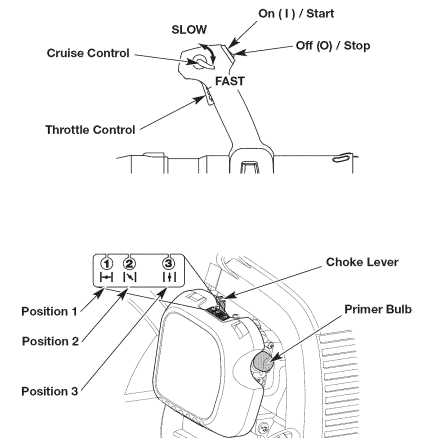
NOTE: The engine is properly warmed up when it accelerates without hesitation.
NOTE: Once the engine is properly warmed, the cruise control may be adjusted and the throttle control can be used normally.
- If the engine does not start, begin the starting procedure with.
- If the engine fails to start after a few attempts, move the choke lever to Position 3 and squeeze the throttle control. Pull the starter rope with a controlled and steady motion 3 to 8 times. The engine should start. If it does not, repeat this instruction.
- If the engine is already warm, begin the starting procedure with.
USING THE SPEED START ACCESSORY
NOTE: This unit can use a Speed Start Accessory!
Please refer to the Speed Start accessory operator's manual for the proper use of this feature. (Items Sold Separately! Refer to the Speed Start Accessory section of this manual for more information about these Speed Start™ accessories.)
STARTING INSTRUCTIONS
- Check the oil level. Refer to Checking the Oil Level.
- Fill the fuel tank. Refer to Fueling the Unit.
NOTE: There is no need to turn the unit on. The On/Off switch is in the ON ( I ) position at all times. - Slowly press and release the primer bulb 10 times (Fig. 11 ). If fuel cannot be seen in the primer bulb, press and release the primer bulb until fuel is visible.
- Move the choke lever to Position 1.
NOTE: DO NOT squeeze the throttle control until step 11. - Crouch in the starting position .
- Insert the Speed Start™ accessory into the Speed Start™ port (Fig. 26). Refer to the Operation section of the Speed Start™ accessory operator's manual.
- DO NOT squeeze the throttle control. Run the Speed Start™ accessory for 2 seconds.
- DO NOT squeeze the throttle control. Move the choke lever to Position 2.
- DO NOT squeeze the throttle control. Run the Speed Start™ accessory in intervals no longer than 2 seconds each until the unit starts.
- Remove the Speed Start™ accessory from the unit.
- Squeeze and hold the throttle control. Allow the engine to warm up for 30 to 60 seconds.
- Continue to squeeze the throttle control. Move the choke lever to Position 3 and continue warming the engine for an additional 60 seconds. The unit may be used during this time.
NOTE: The engine is properly warmed up when it accelerates without hesitation.
NOTE: Once the engine is properly warmed, the cruise control may be adjusted and the throttle control can be used normally.
Operations
WARNING: To prevent serious personal injury, never operate the unit without the blower tubes firmly installed.
WARNING: Always wear eye, hearing, hand, foot and body protection to reduce the risk of injury when operating this unit. Wear a face mask or dust mask if the operation is dusty.
PUTTING ON AND TAKING OFF THE UNIT
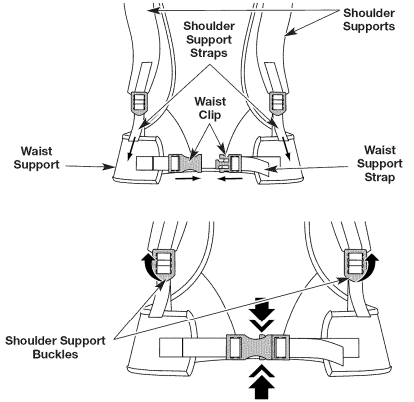
Putting On the Unit
- Place the shoulder supports over both shoulders. The engine should rest securely on the operator's back.
- Insert one end of the waist clip into the other end until it locks into place.
- Pull the shoulder support straps down to tighten the shoulder supports Pull the waist support strap to the left to tighten the waist support.
NOTE: Start the unit before putting it on. Refer to Starting and Stopping.
Taking Off the Unit
- Pull the tabs on the bottom of the shoulder support buckles up to loosen the shoulder supports. Pull the tab on the waist clip up to loosen the waist support.
- Squeeze the top and bottom of the waist clip to disconnect the waist clip.
- Remove the unit.
HOLDING THE UNIT
- Stand in the operating position.
- Hold the throttle grip with the right hand. Keep the right arm slightly bent.
Make sure the unit is secure and comfortable on the operator's back.
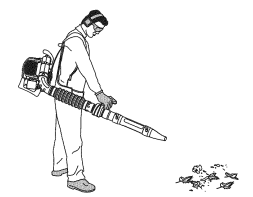
TIPS FOR BEST RESULTS
- Conserve water by using the blower instead of a hose to perform many outdoor cleaning actions.
- Operate the unit only at reasonable hours, not early in the morning or late at night when people might be disturbed. Comply with times listed in local ordinances. Usual recommendations are 9:00 a.m. to 5:00 p.m., Monday through Saturday.
- To reduce noise levels, operate the unit at the lowest speed needed to do the job. Limit the number of pieces of power equipment used at any one time.
- Use rakes or brooms to loosen debris before blowing.
- In dusty conditions, slightly dampen surfaces.
- Watch out for children, pets, open windows and freshly washed cars. Blow debris safely away. Never direct the unit toward anyone while the unit is in operation.
- Use the nozzle to concentrate the air stream closer to the ground.
- Use the cruise control to make continuous operation easier.
- Clean up after operation. Dispose of debris appropriately.
Maintenance
WARNING: To prevent serious injury, never perform maintenance or repairs while the unit is running. Always allow the unit to cool before servicing or repairing the unit. Disconnect the spark plug wire to prevent the unit from starting accidentally.
MAINTENANCE SCHEDULE
Perform these required maintenance procedures at the frequency stated in the table. These procedures should also be a part of any seasonal tune-up.
NOTE: Some maintenance procedures may require special tools or skills. If unsure about these procedures, take the unit to a Sears or other qualified service dealer.
NOTE: Maintenance, replacement, or repair of the emission control devices and system may be performed by a Sears or other qualified service dealer.
NOTE: Please read the California/EPA statement that came with the unit for a complete listing of terms and coverage for the emissions control devices, such as the spark arrestor, muffler, carburetor, etc.
FREQUENCY: Every 10 hours
MAINTENANCE REQUIRED: Clean and re-oil the air filter. Refer to Maintaining the Air Filter.
FREQUENCY: After the first 10 hours and every 25 hours
MAINTENANCE REQUIRED: Change the oil. Refer to Changing the Oil.
MAINTENANCE REQUIRED: Check the rocker arm clearance. Refer to Checking the Rocker Arm Clearance.
MAINTENANCE REQUIRED: Check the spark plug condition and gap. Refer to Maintaining the Spark Plug.
CHECKING THE OIL LEVEL

WARNING: OVERFILLING THE CRANKCASE MAY CAUSE SERIOUS PERSONAL INJURY. Check the oil level before each use. The importance of maintaining the proper oil level cannot be overemphasized.
- Stop the engine and allow it to cool.
- Set the unit on a flat, level surface, such as a workbench or table.
NOTE: Failure to keep the engine level may cause the oil to overfill. - Clean the area around the oil fill plug (Fig. 8) to prevent debris from entering the oil fill hole.
- Unscrew the oil fill plug.
- Look into the oil fill hole; use a flashlight if necessary. The oil level should just touch the bottom thread of the oil fill hole. If the oil level is too low, add oil to the oil fill hole until the oil level touches the bottom thread of the oil fill hole.
NOTE: DO NOT overfill the crankcase. - Wipe up any oil that may have spilled.
- Reinstall the oil fill plug.
CHANGING THE OIL

Change the oil while the engine is still warm. The oil will flow freely and carry away more impurities.
- Clean the area around the oil fill plug to prevent debris from entering the oil fill hole.
- Unscrew the oil fill plug.
- Tip the unit to the side to pour the oil out of the oil fill hole and into a container. Allow ample time for complete drainage.
NOTE: Dispose of the old oil according to federal, state and local regulations. - Wipe up any oil that may have spilled.
- Tilt the unit 30° to the side.
- Pour 3.04 fl.oz. (90 ml) of SAE 30 SJ oil into the oil fill hole.
NOTE: DO NOT overfill. Refer to Checking the Oil Level.
NOTE: Use the empty oil bottle saved from the initial use to measure the correct amount of oil. Fill the bottle to the top of the label to approximate 3.04 fl.oz. (90 ml) of oil. - Wipe up any oil that may have spilled.
- Reinstall the oil fill plug.
MAINTAINING THE AIR FILTER

WARNING: To avoid serious personal injury, always stop .. the engine and allow it to cool before cleaning or maintaining the unit.
Failure to maintain the air filter can result in poor performance or can cause permanent damage to the engine. Engine failure due to improper air filter maintenance is not covered by the product warranty.
Cleaning the Air Filter
- Remove the air filter cover: press in the lock tab and swing the air filter cover up.
- Remove the air filter.
- Wash the air filter in detergent and water. Rinse the air filter thoroughly and allow it to dry.
- Lightly coat the air filter with clean SAE 30 oil.
- Squeeze the air filter to spread and remove excess oil.
- Reinstall the air filter.
NOTE: Operating the unit without the air filter and air filter cover will VOID the warranty. - Reinstall the air filter cover: place the slots on the air filter cover onto the tabs on the backplate. Swing the air filter cover down and press it closed until the lock tab snaps into place.
ADJUSTING THE IDLE SPEED
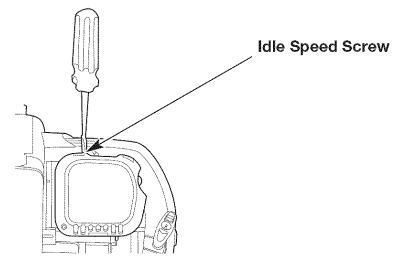
WARNING: Wear protective clothing and observe all safety instructions to prevent serious personal injury.
NOTE: Careless adjustments can seriously damage the unit. A Sears or other qualified service dealer should make carburetor adjustments. If, after checking the fuel and cleaning the air filter, the engine still will not idle, adjust the idle speed screw as follows:
- Start the engine. Refer to Starting and Stopping.
- Move the cruise control to the SLOW position and let the engine idle. If the engine stops, use a small Phillips screwdriver to turn the idle speed screw clockwise, 1 /8 of a turn at a time (as needed) until the engine idles smoothly.
- If the engine is idling too quickly, turn the idle speed screw counterclockwise, 1 /8 of a turn at a time (as needed) to reduce the idle speed.
Checking the fuel, cleaning the air filter, and adjusting the idle speed should solve most engine problems. If not, and any of the following conditions are true, take the unit to a Sears or other qualified service dealer:
- the engine will not idle
- the engine hesitates or stalls on acceleration
- there is a loss of engine power
CHECKING THE ROCKER ARM CLEARANCE
This adjustment requires disassembly of the engine. If you feel unsure or unqualified to perform this, take the unit to a Sears or other qualified service dealer. The engine must be cold when checking or adjusting the rocker arm clearance. This task should be performed inside, in a clean, dust free area.
- Remove the 7 screws from the engine cover with a flat-head screwdriver or T-25 Torx screwdriver. Remove the engine cover.
- Disconnect the spark plug wire.
- Clean the area around the spark plug.
- Remove the spark plug from the cylinder with a 5/8 in. socket, turning counterclockwise.
- Clean the rocker arm cover.
Remove the screw from the rocker arm cover with a flat-head screwdriver or T-25 Torx screwdriver. Remove the rocker arm cover and gasket.
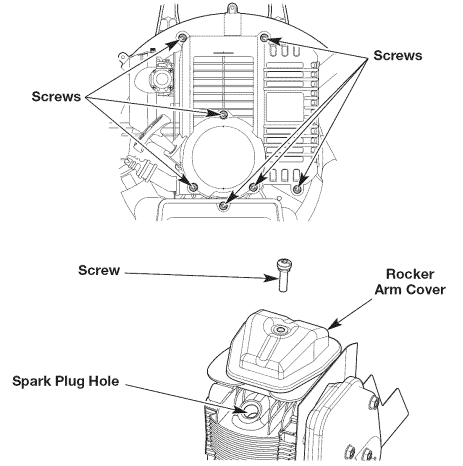
- Look into the spark plug hole and pull the starter rope slowly to move the piston. Make sure:
- The piston is at the top of its travel (top dead center)
- Both rocker arms move freely and both valves are closed
- If these statements are not true, repeat this step.
- Use a feeler gauge to measure the clearance between one of the valve stems and its corresponding rocker arm. Repeat this process for the other valve stem and rocker arm. The recommended clearance is 0.003 - 0.006 in. (0.076- 0.152 mm}. Use a standard automotive 0.005 in. (0.127 mm) feeler gauge. The feeler gauge should slide between the rocker arm and valve stem with a slight amount of resistance, without binding (Fig. 24).
- If the clearance is not within specification:
- Turn the adjusting nut with a 5/16 inch (8 mm) wrench or nut driver.
- To increase clearance, turn the adjusting nut counterclockwise.
- To decrease clearance, turn the adjusting nut clockwise.
- Recheck both clearances and adjust as necessary.
- Install a new gasket and reinstall the rocker arm cover. Torque the screw to: 20-30 in lb (2.2-3.4 Nm).
- Inspect and reinstall the spark plug. Refer to Maintaining the Spark Plug.
- Reconnect the spark plug wire.
Reinstall the engine cover. Check the alignment of the engine cover before tightening the screws. Tighten the screws.
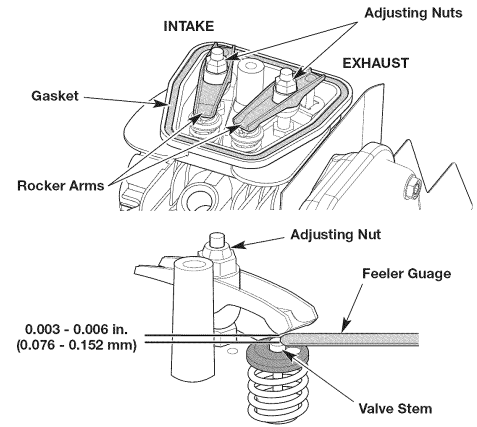
MAINTAINING THE SPARK PLUG
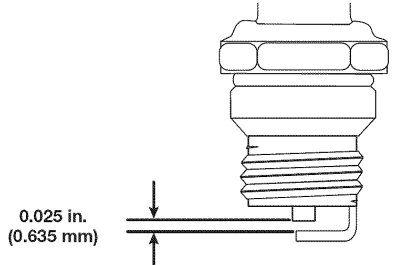
- Stop the engine and allow it to cool.
- Remove the 7 screws from the engine cover with a flat-head screwdriver or T-25 Torx screwdriver.. Remove the engine cover.
- Grasp the spark plug boot firmly and pull it from the spark plug.
- Clean around the spark plug. Remove the spark plug from the cylinder head with a 5/8-inch socket, turning counterclockwise.
WARNING: Do not sand blast, scrape or clean spark plug electrodes. Grit in the engine could damage the cylinder. - Inspect the spark plug. If the spark plug is cracked, fouled or dirty, replace it with a replacement part #753-05784, a Champion RDZ4H or an equivalent spark plug.
- Use a feeler gauge to set the air gap at 0.025 in. (0.635 mm}.
- Install the spark plug in the cylinder head. Tighten the spark plug with a 5/8-inch socket, turning it clockwise until snug.
- Reattach the spark plug boot.
- Reinstall the engine cover. Check the alignment of the engine cover before tightening the screws. Tighten the screws.
Cleaning & Storage
CLEANING
WARNING: To avoid serious personal injury, always stop .. the engine and allow it to cool before cleaning or maintaining the unit.
Use a small brush to clean the outside of the unit. Do not use strong detergents. Household cleaners that contain aromatic oils such as pine and lemon, and solvents such as kerosene, can damage plastic. Wipe off any moisture with a soft cloth.
STORAGE
- Never store a fueled unit where fumes may reach an open flame or spark.
- Allow the engine to cool before storing.
- Lock up the unit to prevent unauthorized use or damage.
- Store the unit in a dry, well-ventilated area.
- Store the unit out of the reach of children.
Long-term Storage
- Remove the fuel cap, tip the unit and drain the fuel into an approved container. Reinstall the fuel cap.
- Start the engine and allow it to run until it stalls. This ensures that all fuel has been drained from the carburetor.
- Allow the engine to cool. Remove the spark plug and put 5 drops of any high quality motor oil into the cylinder. Pull the starter rope slowly to distribute the oil. Reinstall the spark plug.
- Thoroughly clean the unit and inspect it for any loose or damaged parts. Repair or replace damaged parts and tighten loose screws, nuts or bolts.
Preparing the Unit for Use after long-term Storage
- Remove the spark plug and drain all of the oil from the cylinder.
- Change the oil. Refer to Changing the Oil.
NOTE: Do not use fuel that has been stored for more than 30 days. Dispose of old fuel and oil according to federal, state and local regulations.
Speed Start Accessory

- 316.85951 Plug-In Power Start
- 316.85952 Power Bit Start
- 316.85953 Cordless Power Start
Description
The Craftsman Electric Start Capable Backpack is a game-changer for anyone who uses outdoor power equipment. With its electric start capability, you can forget about the hassle of pulling a cord to start your equipment. Simply press a button and you're ready to go. The backpack features a rechargeable battery that provides up to 8 hours of run time, so you can work all day without needing to recharge. It's compatible with a wide range of Craftsman equipment, including chainsaws, leaf blowers, and hedge trimmers, making it a versatile tool for all your outdoor power needs.
The backpack is designed with comfort in mind, featuring padded shoulder straps and a back panel that distributes the weight evenly for a comfortable fit. The durable construction ensures that it can withstand the rigors of outdoor use, while the built-in LED light provides visibility in low-light conditions. At just 20 lbs, it's easy to transport and store when not in use.
IMPORTANT SAFETY INSTRUCTIONS
READ ALL INSTRUCTIONS BEFORE OPERATING
WARNING: When using the unit, all safety rules must be followed. Please read these instructions before operating the unit in order to ensure the safety of the operator and any bystanders. Please keep these instructions for later use.
- Read the instructions carefully. Be familiar with the controls and proper use of the unit.
- Do not operate this unit when tired, ill or under the influence of alcohol, drugs or medication.
- Children must not operate the unit. Teens must be accompanied and guided by an adult.
- Inspect the unit before use. Replace damaged parts. Check for fuel leaks. Make sure all fasteners are in place and secure. Replace parts that are cracked, chipped, or damaged in any way.
- All guards and safety attachments must be installed properly before operating the unit.
- Be aware of risk of injury to the head, hands and feet.
- Carefully inspect the area before starting the unit. Remove all debris that can be thrown or become entangled with the unit, such as rocks, glass, nails, wire, string, etc.
- Clear the area of children, bystanders and pets; keep them outside a 50-foot (15 m) radius, at a minimum. Even then, they are still at risk from thrown objects. Encourage bystanders to wear eye protection. If you are approached, stop the unit immediately.
- Squeeze the throttle control and check that it returns automatically to the idle position. Make all adjustments or repairs before using the unit.
SAFETY WARNINGS FOR GAS UNITS
WARNING: Gasoline is highly flammable and its vapors can explode if ignited. Take the following precautions:
- Store fuel only in containers specifically designed and approved for the storage of such materials.
- Always stop the engine and allow it to cool before filling the tank. Never remove the fuel tank cap or add fuel when the engine is hot. Always loosen the fuel tank cap slowly to relieve any pressure in the tank before fueling.
- Always add fuel in a clean, well-ventilated outdoor area where there are no sparks or flames. DO NOT smoke.
- Never operate the unit without the fuel cap securely in place.
- Avoid creating a source of ignition for spilled fuel. Wipe up any spilled fuel from the unit immediately, before starting the unit. Move the unit at least 30 ft. (9.1 m) from the fueling source and site before starting the engine. DO NOT smoke.
- Never start or run the unit inside a closed room or building. Breathing exhaust fumes can kill. Operate this unit only in a well ventilated outdoor area.
WHILE OPERATING
- Wear safety glasses or goggles that meet current ANSI Z87.1 standards and are marked as such. Wear ear/hearing protection when operating this unit. Wear aa face or dust mask if the operation is dusty.
- Wear heavy long pants, boots, gloves and a long sleeve shirt. Do not wear loose clothing, jewelry, short pants, sandals or go barefoot. Secure hair above shoulder level.
- Use the unit only in daylight or good artificial light.
- Avoid accidental starting. Be in the starting position whenever pulling the starter rope. The operator and unit must be in a stable position while starting. Refer to Starting and Stopping.
- Use the right tool. Only use this tool for its intended purpose.
- Always hold the unit with both hands when operating. Keep a firm grip on both handles or grips.
- Keep hands, face, and feet away from all moving parts. Do not touch or try to stop any moving parts while they are in motion.
- Do not touch the engine, gear housing or muffler. These parts get extremely hot from operation, even after the unit is turned off.
- Do not operate the unit faster than the speed needed to do the job. Do not run the unit at high speed when not in use.
- Always stop the unit when operation is delayed or when walking from one location to another.
- Do not force the unit. It will do a better, safer job when used at the intended rate.
- Do not overreach or use the unit from unstable surfaces such as ladders, trees, steep slopes, rooftops, etc. Always keep proper footing and balance.
- If you strike or become entangled with a foreign object, stop the engine immediately and check for damage. Do not operate before repairing damage. Do not operate the unit with loose or damaged parts.
- Turn the engine to off and disconnect the spark plug for maintenance or repair.
- Use only original equipment manufacturer (OEM) replacement parts and accessories for this unit, as listed in the Parts List section of this manual. Use of any other parts or accessories could lead to serious injury to the user, or damage to the unit, and void the warranty.
- Keep the unit clean of vegetation and other materials that may clog, gum or bind moving parts.
- To reduce fire hazard, replace a faulty muffler and spark arrestor. Keep the engine and muffler free from grass, leaves, excessive grease or carbon build up.
BLOWER SAFETY
- Do not insert anything into the air openings, blower tubes or nozzle. Do not operate the unit if any of the air openings or tubes are blocked. Keep the air openings free from dust, lint, hair and anything else that may reduce airflow.
- Do not operate the unit without the blower tubes attached.
- Do not use the unit to spray liquids, especially flammable or combustible liquids, such as gasoline. Do not use the unit in areas where such liquids are present.
- Do not use the unit for spreading chemicals, fertilizer or any other substance that may contain toxic materials.
- Do not set the unit down on any surface while the unit is running. Debris can be picked up by the air intake and thrown out the discharge opening, resulting in damage to the unit or property or causing serious injury to bystanders or the operator.
- During operation, never point the unit in the direction of people, animals, windows or automobiles. Always direct blowing debris away from people, animals, windows or automobiles.
- Use extra caution when blowing debris near solid objects, such trees, walls, fences, etc. When possible, blow away from such objects, not toward them.
- Take care when working near valuable plants. The force of the blown air could damage tender plants.
OTHER SAFETY WARNINGS
- Stop the engine, make sure all moving parts have stopped, allow the unit to cool and disconnect the spark plug wire before performing any maintenence or replacing any parts on the unit.
- Never store the unit with fuel in the tank, inside a building where fumes may reach an open flame (pilot lights, etc.) or sparks (switches, electrical motors, etc.).
- Allow the engine to cool before storing or transporting. Be sure to secure the unit while transporting.
- Store the unit in a dry place, secured or at a height to prevent unauthorized use or damage. Keep out of the reach of children.
- Never douse or squirt the unit with water or any other liquid. Keep handles dry, clean and free from debris. Clean after each use, see Cleaning and Storage instructions.
- Keep these instructions. Refer to them often and use them to instruct other users. If you loan this unit to others, also loan them these instructions.
SAFETY & INTERNATIONAL SYMBOLS
Warranty
FOR TWO YEARS from the date of purchase, this product is warranted against any defects in material or workmanship. A defective product will receive free repair or replacement if repair is unavailable. For warranty coverage details to obtain free repair or replacement, visit the web site: https://www.craftsman.com/ .
Troubleshooting
PROBLEM: THE ENGINE WILL NOT START
The fuel tank is empty: Fill the fuel tank with fresh fuel.
The primer bulb was not pressed enough: Press the primer bulb 10 times or until fuel is visible.
The fuel is old (over 30 days): Drain the fuel tank and add fresh fuel.
The spark plug is fouled: Replace the spark plug.
PROBLEM: THE ENGINE WILL NOT IDLE
The air filter is dirty: Clean or replace the air filter.
The fuel is old (over 30 days): Drain the fuel tank and add fresh fuel.
The idle speed is incorrect: Adjust the idle speed.
PROBLEM: THE ENGINE WILL NOT ACCELERATE
The fuel is old (over 30 days): Drain the fuel tank and add fresh fuel.
The air filter is dirty: Clean or replace the air filter.
PROBLEM: THE ENGINE LACKS POWER OR STALLS
The fuel is old (over 30 days): Drain the fuel tank and add fresh fuel.
The air filter is dirty: Clean or replace the air filter.
The spark plug is fouled: Replace the spark plug.
Pros & Cons
Pros
- Electric start capability for easy starting
- Long-lasting battery life
- Comfortable fit and durable construction
- Versatile and compatible with a wide range of Craftsman equipment
- Includes a 3-year limited warranty
Cons
- May be too expensive for some users
- Rechargeable battery may need to be replaced over time
- May not be compatible with non-Craftsman equipment
- May be too heavy for some users
Customer Reviews
Customers love the Craftsman Electric Start Capable Backpack for its ease of use and long-lasting battery life. They appreciate the comfortable fit and durable construction, as well as the versatility of being able to use it with a wide range of Craftsman equipment. However, some users have noted that the rechargeable battery may need to be replaced over time, and that the backpack may be too heavy for some users. Overall, customers are happy with their purchase and would recommend it to others.
Faqs
What is the electric start capability of the Craftsman Electric Start Capable Backpack?
How long does the battery last on the Craftsman Electric Start Capable Backpack?
What equipment is compatible with the Craftsman Electric Start Capable Backpack?
What is the Craftsman Electric Start Capable Backpack?
How does the electric start function work on the Craftsman Electric Start Capable Backpack?
Can the Craftsman Electric Start Capable Backpack be used in wet or rainy conditions?
Can the Craftsman Electric Start Capable Backpack be used with non-Craftsman equipment?
How long does it take to charge the battery on the Craftsman Electric Start Capable Backpack?
How long does the battery last on the Craftsman Electric Start Capable Backpack?
What is the warranty on the Craftsman Craftsman Electric Start Capable Backpack?
Leave a Comment
